Report From the TV Academy Faculty Seminar (Part 2)
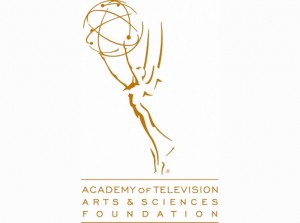 Every fall, the Academy of Television Arts & Sciences Foundation invites twenty Media Studies and Production faculty members out to Los Angeles for a week of panels and studio visits hosted by TV industry insiders with the intention of fostering ties between the industry and academia and offering professors relevant information to pass on to students who hope to build careers in the entertainment industry. Across two Antenna posts, six attendees share impressions from this year’s seminar. Part One offered teaching takeaways. Part Two raises questions about television’s future.
Every fall, the Academy of Television Arts & Sciences Foundation invites twenty Media Studies and Production faculty members out to Los Angeles for a week of panels and studio visits hosted by TV industry insiders with the intention of fostering ties between the industry and academia and offering professors relevant information to pass on to students who hope to build careers in the entertainment industry. Across two Antenna posts, six attendees share impressions from this year’s seminar. Part One offered teaching takeaways. Part Two raises questions about television’s future.
Tasha Oren, University of Wisconsin-Milwaukee:
Throughout the week-long series of captivating panels, an intriguing, contradictory through-line quickly emerged: TV is where it’s at for creative concepts and serious long-form storytelling; its three-tiered system of network/cable/premium and its monetized structure of ads, fees, syndication and subscriptions is optimized, robust and plenty profitable; and yet, TV as we know it is living on borrowed time. For the ad-supported (and measurement-dependent) aspect of the industry in particular, the decade-long, incremental growth of streaming options, preference for DVR and binge-watching, and content competition has been heating to a boil. As many acknowledged over the week, the industry is reluctant and slow to change. How various sectors and networks are dealing with the inevitability/opportunity of change present a fascinating study in industry culture and the guesswork around audience-habits.
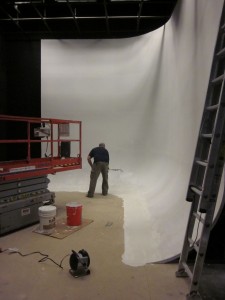
A green screen studio under construction at the brand new YouTube Hanger production facility in Los Angeles.
Three consecutive panels were illustrative of the strange co-existence of the glacial with the seismic in the TV ecosystem: midway through the seminar, we toured the Warners Bros. multi-camera studio sets for Conan, The Big Bang Theory and Two and a Half Men as veteran production designer John Shaffner spoke lovingly about the process of design and fabrication, the long history and weekly routine of the multi-camera production, the craft’s apprentice-based tradition, and the current sitcom revival on network.
The following day found us at the nearly completed headquarters of the YouTube Hanger, a slick, massive production facility that houses sound stages, green screen stations, editing and sound bays, a plush screening room, and various upholstered and funkified conversation nooks, all designed for comfort and spontaneous collaboration. This, Liam Collins, Head of YouTube LA Creative Space, told us would be the incubator for talent, where creators learn new skills, collaborate, and use the equipment (for free!) to develop original content. YouTube’s audience measurement emphasis, we learned, was rapidly shifting away from a “hits based” model to repeat views, as it encouraged its successful content-makers to look towards channel-based structures. At the LA hanger (as well as networked and similar facilities in New York, London and Tokyo), “top channel creators” would be invited to produce content, enhance their skills and raise production values, all with an eye towards series-development and long-form content. YouTube, we whispered to each other, was growing a TV network.
Yet the broadcast network schedulers we met on the final day of the seminar calmly swatted away our “YouTube’s coming for ya!” provocation. Content, they insisted, isn’t easy, and the skill to deliver good content, satisfying storytelling, and branded experience was the industry’s hard-earned, years-in-the-making edge over all shortcutting upstarts, no matter their Google-sized pockets. However, the radical changes in audience habits and content delivery options are producing changes, albeit slowly. CW, among others, has struck a direct up-put deal with Netflix, which now functions as a de facto syndicator (the more veteran the show, the higher the fee). Network schedule-logic is also slowly shifting from managing audience behavior and shepherding specific time and day viewership to managing content assets and nourishing shows. Networks are less quick to pull programming as popular viewership patterns (as well as ratings collection) expand in time. Season demarcations are loosening with the proliferation of cable-inspired, short order runs and more flexible episodes-per-season configurations. And, perhaps most dramatically, “brand envelopes” and single-sponsorship models for content are now discussed as valid and even likely alternatives to traditional spot-advertising.
The vexing problem of launching a new show in an on-demand universe prompted many schedulers to insist on the relevance of the grid-and-season logic of conventional television. What’s more, they suggested, adult audiences continue to gravitate towards the comfy sofa and the largest screen in the house for evening viewing. “Yes,” Kelly Kahl of CBS concluded, “we’ll get you in the end…”
Kim Owczarski, Texas Christian University:
As professors from varying types of higher education institutions across the United States, many of us tried to ask questions about what opportunities the current television industry holds for our students entering the marketplace in the near future. During one panel, a television producer/director stressed that students should be making “shitty films” and posting them given that the access to distribution has been critically aided by the Internet. He argued that you can buy equipment from Amazon and return it 28 days later, so you don’t even need to truly own cameras and such any more to be making art.
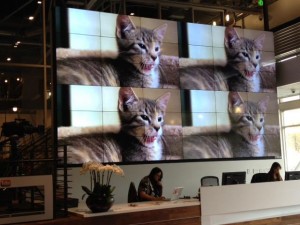
YouTube Hanger's lobby indicates that even in a new era of professionalized content, cat videos will still be revered.
Yet, our trip to the brand new, state-of-the-art YouTube Hangar suggested that the distribution platform is seeking professionalized content above that grade. With YouTube bringing in a new class of content creators every quarter, it seems that the company is moving away from the “shitty films” category to a more optimized strategy of monetizing content that is similar to what the television networks produce. It did not seem that the company’s resources were really within the realm of the novice filmmaker any more.
As far as first jobs, other professionals stressed the importance of moving to Los Angeles and working in those first low paid jobs as production assistants or in the mail room, and that as long as you worked harder than anyone else, you will be fine. Though runaway production and its impact on the television employment sector of Los Angeles kept coming up, few of the panelists thought it was a good idea to chase the jobs elsewhere as many key aspects of the industry—including writing, editing, scheduling, and marketing—continued to be centered in California.
The issue of the importance of long-term, stable employment seemed to be an important focus for those working in the industry, albeit rarely was it discussed in a direct fashion. During our tour of the Warner Bros. studios, John Shaffner stressed how great the three-camera setup of a traditional sitcom is for those who need to pay for their kids’ college educations. He also discussed at length what dealing with Charlie Sheen on that last season of Two and a Half Men was like for a below-the-line crew depending upon a regular paycheck.
During the panel with the five scheduling heads of the broadcast networks, the idea of shorter versus longer seasons was debated about its overall impact on a network. One mentioned that it would be great to have shorter seasons on broadcast in order to buff up their international appeal (as foreign broadcasters seem to prefer the shorter, more quality based seasons of cable) while another quipped that he’d love to release 30 episodes of his top shows if he could. As we learned from the panel with the showrunners, putting out 22 quality episodes a season is an extremely difficult proposition given the time and financial constraints operating on most television programs. But regardless of whether a show pumps out 13 episodes or 22 in a season, it goes without saying that the stability it provides for a large assortment of professionals is a big reason why the broadcast networks are hesitant to fully embrace the cable model despite the change in series quality such a move might engender.
Christine Becker, University of Notre Dame:
Tasha’s observation about mixed signals also holds for what various speakers said about the value of social media in the TV ecosystem. For instance, the showrunners insisted they paid social media activity little mind, but then each followed with an example of when they drew from its value. Former House showrunner Greg Yaitanes said that because such a small percentage of viewers tweet, you can’t consider their reactions to be representative or to offer any kind of consensus, but he then discussed how useful fan input was for the creation of a House app, which presumably brought in revenue. Similarly, The Middle showrunner DeAnn Heline expressed surprise that people out there write up lengthy blog posts on individual episodes (“These people care more than I do,” she joked) and stressed that writers wouldn’t change their approach based on what people are tweeting, but then acknowledged that her writers did see people tweeting about watching The Middle together as a family and now bear that in mind.
The network schedulers were just as dismissive of Twitter and its brethren, noting that while it might offer some marketing utility, social media activity does not correlate with their revenue currency, Nielsen ratings. The network scheduling panel moderator was the COO of the TV Academy, and he pointed out that the “OMG, Tracy Morgan just passed out on stage at the Emmys, turn on ABC” moment trended instantly on Twitter but didn’t bring so much as a blip in the ratings. Seminar participant and Northwestern professor Max Dawson then pointed out that many of the tweets were about how stupid this gimmick was. Dawson also asked CBS’s programmer Kelly Kahl why the network bothers with generating on-screen hashtags during Survivor episodes if they don’t see Twitter as particularly valuable, and Kahl responded that the network will do anything it can to suck in viewers, plus it’s no extra cost to throw a hashtag up on the screen. So it’s not useful except when maybe it is.
I certainly get the bottom line idea that tweets aren’t ratings and that Twitter activity can misrepresent where the real value of a show lies. And the network programmer who recently told EW that TV fans can only save shows from cancellation by watching the programs and their advertisements within three days is partially right. But his statement doesn’t acknowledge that only Nielsen households have this power, not TV fans. Incidentally, this programmer was anonymous in the article, but identified himself on Twitter. Part of the gratification of social media is feeling like someone might actually be paying attention to what you’re saying. Given the battle for viewer engagement taking place on screens of all sorts, you would figure there has to be monetary value in that too.

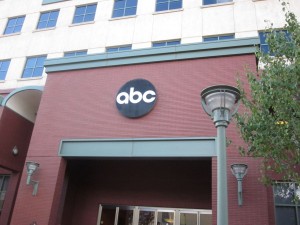
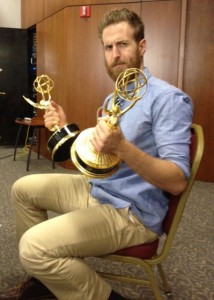


Great posts! You each made fascinating points about the conflicting discourses within the TV industry. The Faculty Seminar is an excellent opportunity to witness these up close. When I attended in 2008, I was struck by the contrasting attitudes toward new audience behaviors: the broadcast network schedulers were easily the most dismissive; the cable network program executives the most interested. Back then the broadcast network execs insisted that as viewers age, they will cease timeshifting & placeshifting and return to the living room couch and linear TV. Interesting to hear they still believe this!
Thanks, Tasha, for the remark about the co-existence of changes both glacial and seismic–great image!
Thanks for the comments, Cynthia! I had noticed that in the 2010 Antenna post about the Faculty Seminar, the same idea came up, including in your comment about 2008 (see /2010/11/22/lessons-from-los-angeles-top-takeaways-from-the-tv-academy-part-one/) . It’s clear that the schedulers are invested in maintaining continuity in traditional practices, even as the industry is shifting beneath their feet. I now can’t wait for future seminar posts to see if the same thing gets expressed. 🙂 And I agree that Tasha’s characterization of the glacial-seismic change dichotomy in the industry is spot-on. Such a perfect description, one I will use henceforth in describing this era to my students.